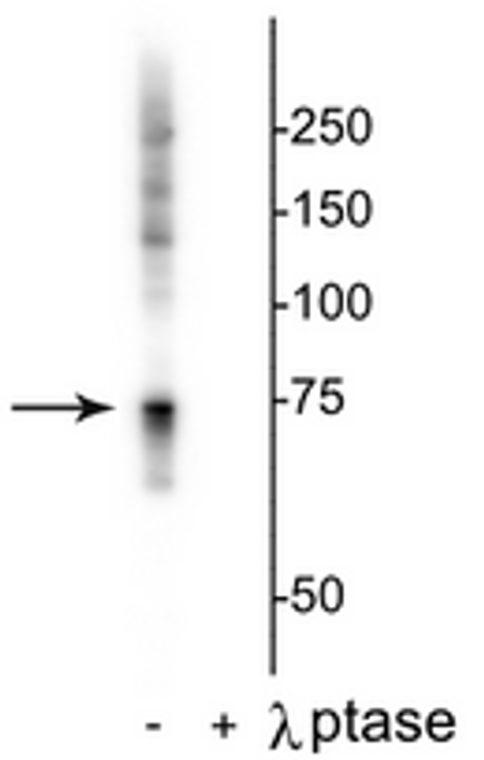| Host: |
Rabbit |
| Applications: |
WB |
| Reactivity: |
Human/Rat/Bovine/Canine/Chicken/Mouse/Non-Human Primates |
| Note: |
STRICTLY FOR FURTHER SCIENTIFIC RESEARCH USE ONLY (RUO). MUST NOT TO BE USED IN DIAGNOSTIC OR THERAPEUTIC APPLICATIONS. |
| Short Description: |
Rabbit polyclonal antibody anti-Phospho-Raf-1-Ser642 is suitable for use in Western Blot research applications. |
| Clonality: |
Polyclonal |
| Conjugation: |
Unconjugated |
| Isotype: |
IgG |
| Formulation: |
100 µl in 10 mM HEPES (pH 7.5) , 150 mM NaCl, 100 µg per ml BSA and 50% Glycerol. |
| Purification: |
This antibody was antigen affinity purified from serum. |
| Dilution Range: |
WB 1:1000IHCICCIP |
| Storage Instruction: |
Store at-20°C for up to 1 year from the date of receipt, and avoid repeat freeze-thaw cycles. |
| Gene Symbol: |
Raf1 |
| Gene ID: |
24703 |
| Uniprot ID: |
RAF1_RAT |
| Immunogen: |
Synthetic phospho-peptide corresponding to amino acid residues surrounding Ser642 conjugated to KLH. |
| Post Translational Modifications | Phosphorylation at Thr-269, Ser-338, Tyr-341, Thr-491 and Ser-494 results in its activation. Phosphorylation at Ser-29, Ser-43, Ser-289, Ser-296, Ser-301 and Ser-642 by MAPK1/ERK2 results in its inactivation. Phosphorylation at Ser-259 induces the interaction with YWHAZ and inactivates kinase activity. Dephosphorylation of Ser-259 by the complex containing protein phosphatase 1, SHOC2 and M-Ras/MRAS relieves inactivation, leading to stimulate RAF1 activity. Phosphorylation at Ser-338 by PAK1 and PAK5 and Ser-339 by PAK1 is required for its mitochondrial localization. Phosphorylation at Ser-621 in response to growth factor treatment stabilizes the protein, possibly by preventing proteasomal degradation. Phosphorylation at Ser-289, Ser-296, Ser-301, Ser-338 and Ser-621 are somehow linked to the methylation potential of cells. Treatment of cells with HGF in the presence of the methylation inhibitor 5'-methylthioadenosine (MTA) results in increased phosphorylation at Ser-338 and Ser-621 and decreased phosphorylation at Ser-296, Ser-301 and Ser-338. Dephosphorylation at Ser-338 by PPP5C results in a decreased of activity. Methylated in response to EGF treatment. This modification leads to destabilization of the protein, possibly through proteasomal degradation. |
| Function | Serine/threonine-protein kinase that acts as a regulatory link between the membrane-associated Ras GTPases and the MAPK/ERK cascade, and this critical regulatory link functions as a switch determining cell fate decisions including proliferation, differentiation, apoptosis, survival and oncogenic transformation. RAF1 activation initiates a mitogen-activated protein kinase (MAPK) cascade that comprises a sequential phosphorylation of the dual-specific MAPK kinases (MAP2K1/MEK1 and MAP2K2/MEK2) and the extracellular signal-regulated kinases (MAPK3/ERK1 and MAPK1/ERK2). The phosphorylated form of RAF1 (on residues Ser-338 and Ser-339, by PAK1) phosphorylates BAD/Bcl2-antagonist of cell death at 'Ser-75'. Phosphorylates adenylyl cyclases: ADCY2, ADCY5 and ADCY6, resulting in their activation. Phosphorylates PPP1R12A resulting in inhibition of the phosphatase activity. Can promote NF-kB activation and inhibit signal transducers involved in motility (ROCK2), apoptosis (MAP3K5/ASK1 and STK3/MST2), proliferation and angiogenesis (RB1). Can protect cells from apoptosis also by translocating to the mitochondria where it binds BCL2 and displaces BAD/Bcl2-antagonist of cell death. Regulates Rho signaling and migration, and is required for normal wound healing. Plays a role in the oncogenic transformation of epithelial cells via repression of the TJ protein, occludin (OCLN) by inducing the up-regulation of a transcriptional repressor SNAI2/SLUG, which induces down-regulation of OCLN. Restricts caspase activation in response to selected stimuli, notably Fas stimulation, pathogen-mediated macrophage apoptosis, and erythroid differentiation. Phosphorylates TNNT2/cardiac muscle troponin T. |
| Protein Name | Raf Proto-Oncogene Serine/Threonine-Protein KinaseProto-Oncogene C-RafCrafRaf-1 |
| Database Links | Reactome: R-RNO-2672351Reactome: -RNO-392517Reactome: -RNO-430116Reactome: -RNO-5621575Reactome: -RNO-5673000Reactome: -RNO-5674135Reactome: -RNO-5674499Reactome: -RNO-5675221Reactome: -RNO-9732724 |
| Cellular Localisation | CytoplasmCell MembraneMitochondrionNucleusColocalizes With Rgs14 And Braf In Both The Cytoplasm And MembranesPhosphorylation At Ser-259 Impairs Its Membrane AccumulationRecruited To The Cell Membrane By The Active Ras ProteinPhosphorylation At Ser-338 And Ser-339 By Pak1 Is Required For Its Mitochondrial LocalizationRetinoic Acid-Induced Ser-621 Phosphorylated Form Of Raf1 Is Predominantly Localized At The Nucleus |
| Alternative Antibody Names | Anti-Raf Proto-Oncogene Serine/Threonine-Protein Kinase antibodyAnti-Proto-Oncogene C-Raf antibodyAnti-Craf antibodyAnti-Raf-1 antibodyAnti-Raf1 antibodyAnti-Raf antibody |
Information sourced from Uniprot.org
12 months for antibodies. 6 months for ELISA Kits. Please see website T&Cs for further guidance







